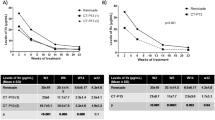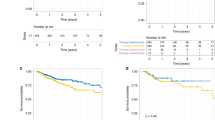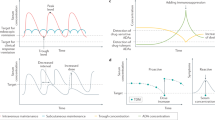Key Points
-
Six biologic agents are currently approved for the treatment of IBD refractory to standard medications: four anti-TNF agents, infliximab, adalimumab, golimumab, certolizumab pegol; and two anti-integrin agents, natalizumab and vedolizumab
-
When choosing a first-line biologic agent, several parameters should be taken into account, including specific country availability and labelling, efficacy and safety profile, route of administration, patient preferences and cost-effectiveness
-
The sequence of prescribing anti-TNF therapies relative to vedolizumab will be assessed in further head-to-head trials; currently, labelling is similar for both drug classes
-
No switch between anti-TNF agents should be proposed in instances of adequate primary response to a first-line anti-TNF therapy
-
For secondary loss of response to a first-line anti-TNF agent, a second-line anti-TNF therapy could be proposed; primary nonresponders should be swaped to biologic agents with a different mechanism of action
-
In the next few years, results of head-to-head trials will be available to help decision-making between therapeutic options for IBD and treatment algorithms will evolve with the launch of biosimilars and new drugs
Abstract
Six biologic agents are currently approved for the treatment of IBD: four anti-TNF agents (infliximab, adalimumab, golimumab and certolizumab pegol) and two anti-integrin agents (natalizumab and vedolizumab). In Crohn's disease and ulcerative colitis refractory to standard medications, treatment choice among available biologic agents can be challenging. Several parameters should be taken into account to help physicians through the decision-making process, including the comparative effectiveness and long-term safety profile, availability and labelling in the prescriber's country, international guidelines, and cost, as well as patient preferences (such as the route of administration). Herein, we provide practical insights on the use of biologic agents in IBD. The results of head-to-head trials between biologic agents are eagerly awaited to guide decision-making regarding the choice of first-line biologic agents and to determine whether switching within the same drug class or swapping (switching out of the drug class) is preferable after primary or secondary loss of response to the first biologic agent. In the near future, treatment algorithms might evolve with the launch of new drugs (such as ustekinumab, tofacitinib and etrolizumab) and the increased use of biosimilars.
This is a preview of subscription content, access via your institution
Access options
Subscribe to this journal
Receive 12 print issues and online access
$209.00 per year
only $17.42 per issue
Buy this article
- Purchase on Springer Link
- Instant access to full article PDF
Prices may be subject to local taxes which are calculated during checkout


Similar content being viewed by others
References
Bodger, K., Kikuchi, T. & Hughes, D. Cost-effectiveness of biological therapy for Crohn's disease: Markov cohort analyses incorporating United Kingdom patient-level cost data. Aliment. Pharmacol. Ther. 30, 265–274 (2009).
Hazlewood, G. S. et al. Comparative effectiveness of immunosuppressants and biologics for inducing and maintaining remission in Crohn's Disease: a network meta-analysis. Gastroenterology 148, 344–354e5 (2015).
Stidham, R. W. et al. Systematic review with network meta-analysis: the efficacy of anti-TNF agents for the treatment of Crohn's disease. Aliment. Pharmacol. Ther. 39, 1349–1362 (2014).
Singh, S. et al. Comparative efficacy of biologic therapy in biologic-naïve patients with Crohn disease: a systematic review and network meta-analysis. Mayo Clin. Proc. 89, 1621–1635 (2014).
Danese, S. et al. Biological agents for moderately to severely active ulcerative colitis: a systematic review and network meta-analysis. Ann. Intern. Med. 160, 704–711 (2014).
Stidham, R. W. et al. Systematic review with network meta-analysis: the efficacy of anti-tumour necrosis factor-alpha agents for the treatment of ulcerative colitis. Aliment. Pharmacol. Ther. 39, 660–671 (2014).
Chaparro, M. et al. Long-term durability of infliximab treatment in Crohn's disease and efficacy of dose 'escalation' in patients losing response. J. Clin. Gastroenterol. 45, 113–118 (2011).
Eshuis, E. J. et al. Ten years of infliximab for Crohn's disease: outcome in 469 patients from 2 tertiary referral centers. Inflamm. Bowel Dis. 19, 1622–1630 (2013).
Reinisch, W. et al. Long-term infliximab maintenance therapy for ulcerative colitis: the ACT-1 and -2 extension studies. Inflamm. Bowel Dis. 18, 201–211 (2012).
Karmiris, K. et al. Influence of trough serum levels and immunogenicity on long-term outcome of adalimumab therapy in Crohn's disease. Gastroenterology 137, 1628–1640 (2009).
Lichtenstein, G. R. et al. Continuous therapy with certolizumab pegol maintains remission of patients with Crohn's disease for up to 18 months. Clin. Gastroenterol. Hepatol. 8, 600–609 (2010).
Parikh, A. et al. Long-term clinical experience with vedolizumab in patients with inflammatory bowel disease. Inflamm. Bowel Dis. 19, 1691–1699 (2013).
Zhang, D., Xiong, B., Li, X., Xu, T. & Yu, M. Meta-analysis: serious adverse events in Crohn's disease patients treated with TNF-alpha inhibitors. Hepatogastroenterology 60, 1333–1342 (2013).
Feagan, B. G. et al. CDP571, a humanized monoclonal antibody to tumour necrosis factor-alpha, for steroid-dependent Crohn's disease: a randomized, double-blind, placebo-controlled trial. Aliment. Pharmacol. Ther. 23, 617–628 (2006).
Singh, S. et al. Inflammatory bowel disease is associated with an increased risk of melanoma: a systematic review and meta-analysis. Clin. Gastroenterol. Hepatol. 12, 210–218 (2014).
Ford, A. C. & Peyrin-Biroulet, L. Opportunistic infections with anti-tumor necrosis factor-α therapy in inflammatory bowel disease: meta-analysis of randomized controlled trials. Am. J. Gastroenterol. 108, 1268–1276 (2013).
Siegel, C. A., Marden, S. M., Persing, S. M., Larson, R. J. & Sands, B. E. Risk of lymphoma associated with combination anti-tumor necrosis factor and immunomodulator therapy for the treatment of Crohn's disease: a meta-analysis. Clin. Gastroenterol. Hepatol. 7, 874–881 (2009).
Williams, C. J. M., Peyrin-Biroulet, L. & Ford, A. C. Systematic review with meta-analysis: malignancies with anti-tumour necrosis factor-α therapy in inflammatory bowel disease. Aliment. Pharmacol. Ther. 39, 447–458 (2014).
Baert, F. et al. Influence of immunogenicity on the long-term efficacy of infliximab in Crohn's disease. N. Engl. J. Med. 348, 601–608 (2003).
Nanda, K. S., Cheifetz, A. S. & Moss, A. C. Impact of antibodies to infliximab on clinical outcomes and serum infliximab levels in patients with inflammatory bowel disease (IBD): a meta-analysis. Am. J. Gastroenterol. 108, 40–47 (2013).
Colombel, J.-F. et al. Association between plasma concentrations of certolizumab pegol and endoscopic outcomes of patients with Crohn's disease. Clin. Gastroenterol. Hepatol. 12, 423–431 (2014).
Bartelds, G. M. et al. Development of antidrug antibodies against adalimumab and association with disease activity and treatment failure during long-term follow-up. JAMA 305, 1460–1468 (2011).
Vermeire, S. et al. Effectiveness of concomitant immunosuppressive therapy in suppressing the formation of antibodies to infliximab in Crohn's disease. Gut 56, 1226–1231 (2007).
Hayes, M. J., Stein, A. C. & Sakuraba, A. Comparison of efficacy, pharmacokinetics, and immunogenicity between infliximab mono- versus combination therapy in ulcerative colitis. J. Gastroenterol. Hepatol. 29, 1177–1185 (2014).
Colombel, J. F. et al. Infliximab, Azathioprine, or Combination Therapy for Crohn's Disease. N. Engl. J. Med. 362, 1383–1395 (2010).
Panaccione, R. et al. Combination therapy with infliximab and azathioprine is superior to monotherapy with either agent in ulcerative colitis. Gastroenterology 146, 392–400e3 (2014).
Dulai, P. S., Siegel, C. A., Colombel, J.-F., Sandborn, W. J. & Peyrin-Biroulet, L. Systematic review: Monotherapy with antitumour necrosis factor α agents versus combination therapy with an immunosuppressive for IBD. Gut 63, 1843–1853 (2014).
US Department of Health & Human Services. Drugs @ FDA - Label and approval history. FDA [online], (2015).
European Medicines Agency. European public assessment reports (infliximab). European Medicines Agency [online], (2015).
US Department of Health & Human Services. Drugs @ FDA - Label and approval history. FDA [online], (2015).
European Medicines Agency. European public assessment reports (adalimumab). European Medicines Agency [online], (2015).
European Medicines Agency. European public assessment reports (golimumab). European Medicines Agency [online], (2015).
US Department of Health & Human Services. Drugs @ FDA - Label and approval history. FDA [online], (2015).
European Medicines Agency. European public assessment reports (certolizumab pegol). European Medicines Agency [online], (2015).
Swissmedic. Cimzia™, poudre et solvant (certolizumab pegol). Swissmedic [online; French] (2015).
US Department of Health & Human Services. Drugs @ FDA - Label and approval history. FDA [online], (2015).
Yousry, T. A. et al. Evaluation of patients treated with natalizumab for progressive multifocal leukoencephalopathy. N. Engl. J. Med. 354, 924–933 (2006).
Danese, S. & Panés, J. Development of drugs to target interactions between leukocytes and endothelial cells and treatment algorithms for inflammatory bowel diseases. Gastroenterology 147, 981–989 (2014).
European Medicines Agency. European public assessment reports (natalizumab). European Medicines Agency [online], (2015).
US Department of Health & Human Services. Drug details - natalizumab. FDA [online], (2015).
US Department of Health & Human Services. Drugs @ FDA - Label and approval history. FDA [online], (2015).
European Medicines Agency. European public assessment reports (vedolizumab). European Medicines Agency [online], (2015).
Bryant, R., Sandborn, W. & Travis, S. Introducing vedolizumab to clinical practice: who, when and how? J. Crohns Colitis 9, 356–366 (2015).
Haute Autorite de Sante. Commission de la transparence. HAS [online; French], (2015).
Lichtenstein, G. R., Hanauer, S. B., Sandborn, W. J. & Practice Parameters Committee of American College of Gastroenterology. Management of Crohn's disease in adults. Am. J. Gastroenterol. 104, 465–483 (2009).
Dignass, A. et al. The second European evidence-based consensus on the diagnosis and management of Crohn's disease: Current management. J. Crohns Colitis 4, 28–62 (2010).
Van Assche, G. et al. The second European evidence-based consensus on the diagnosis and management of Crohn's disease: Special situations. J. Crohns Colitis 4, 63–101 (2010).
Gecse, K. B. et al. A global consensus on the classification, diagnosis and multidisciplinary treatment of perianal fistulising Crohn's disease. Gut 63, 1381–1392 (2014).
Kornbluth, A., Sachar, D. B. & Practice Parameters Committee of the American College of Gastroenterology. Ulcerative colitis practice guidelines in adults: American College Of Gastroenterology, Practice Parameters Committee. Am. J. Gastroenterol. 105, 501–523 (2010).
Dignass, A. et al. Second European evidence-based consensus on the diagnosis and management of ulcerative colitis part 2: current management. J. Crohns Colitis 6, 991–1030 (2012).
Laharie, D. et al. Ciclosporin versus infliximab in patients with severe ulcerative colitis refractory to intravenous steroids: a parallel, open-label randomised controlled trial. Lancet 380, 1909–1915 (2012).
Reinisch, W. et al. Adalimumab for induction of clinical remission in moderately to severely active ulcerative colitis: results of a randomised controlled trial. Gut 60, 780–787 (2011).
Odes, S. et al. Cost analysis and cost determinants in a European inflammatory bowel disease inception cohort with 10 years of follow-up evaluation. Gastroenterology 131, 719–728 (2006).
Bodger, K. Economic implications of biological therapies for Crohn's disease: review of infliximab. Pharmacoeconomics 23, 875–888 (2005).
Van der Valk, M. E. et al. Healthcare costs of inflammatory bowel disease have shifted from hospitalisation and surgery towards anti-TNFα therapy: results from the COIN study. Gut 63, 72–79 (2014).
Dretzke, J. et al. A systematic review and economic evaluation of the use of tumour necrosis factor-alpha (TNF-α) inhibitors, adalimumab and infliximab, for Crohn's disease. Health Technol. Assess. Winch. Engl. 15, 1–244 (2011).
Marchetti, M., Liberato, N. L., Di Sabatino, A. & Corazza, G. R. Cost-effectiveness analysis of top-down versus step-up strategies in patients with newly diagnosed active luminal Crohn's disease. Eur. J. Health Econ. 14, 853–861 (2013).
Saito, S. et al. Economic impact of combination therapy with infliximab plus azathioprine for drug-refractory Crohn's disease: a cost-effectiveness analysis. J. Crohns Colitis 7, 167–174 (2013).
Yu, A. P. et al. Cost utility of adalimumab versus infliximab maintenance therapies in the United States for moderately to severely active Crohn's disease. Pharmacoeconomics 27, 609–621 (2009).
Colombel, J.-F. et al. Adalimumab for maintenance of clinical response and remission in patients with Crohn's disease: the CHARM trial. Gastroenterology 132, 52–65 (2007).
Hanauer, S. B. et al. Maintenance infliximab for Crohn's disease: the ACCENT I randomised trial. Lancet 359, 1541–1549 (2002).
Tang, D. H., Armstrong, E. P. & Lee, J. K. Cost-utility analysis of biologic treatments for moderate-to-severe Crohn's disease. Pharmacotherapy 32, 515–526 (2012).
European Medicines Agency. Questions and answers on biosimilar medicines (similar biological medicinal products). European Medicines Agency [online], (2012).
ViewPoints: Orion Pharma offers an “astonishing” 72 percent discount on biosimilar infliximab in Norway, but at what expense to profitability? First Word Pharma [online].
Rinaudo-Gaujous, M. et al. Review article: biosimilars are the next generation of drugs for liver and gastrointestinal diseases. Aliment. Pharmacol. Ther. 38, 914–924 (2013).
Street, R. L. & Voigt, B. Patient participation in deciding breast cancer treatment and subsequent quality of life. Med. Decis. 17, 298–306 (1997).
Greenfield, S., Kaplan, S. H., Ware, J. E., Yano, E. M. & Frank, H. J. Patients' participation in medical care: effects on blood sugar control and quality of life in diabetes. J. Gen. Intern. Med. 3, 448–457 (1988).
Vavricka, S. R. et al. Systematic assessment of factors influencing preferences of Crohn's disease patients in selecting an anti-tumor necrosis factor agent (CHOOSE TNF TRIAL). Inflamm. Bowel Dis. 18, 1523–1530 (2012).
Williams, E. L. & Edwards, C. J. Patient preferences in choosing anti-TNF therapies-R1. Rheumatol. Oxf. Engl. 45, 1575–1576 (2006).
Ko, J. M., Gottlieb, A. B. & Kerbleski, J. F. Induction and exacerbation of psoriasis with TNF-blockade therapy: a review and analysis of 127 cases. J. Dermatol. Treat. 20, 100–108 (2009).
Rahier, J.-F. et al. Severe skin lesions cause patients with inflammatory bowel disease to discontinue anti-tumor necrosis factor therapy. Clin. Gastroenterol. Hepatol. 8, 1048–1055 (2010).
Tillack, C. et al. Anti-TNF antibody-induced psoriasiform skin lesions in patients with inflammatory bowel disease are characterised by interferon-γ-expressing Th1 cells and IL-17A/IL-22-expressing Th17 cells and respond to anti-IL-12/IL-23 antibody treatment. Gut 63, 567–577 (2014).
Van Assche, G. et al. Switch to adalimumab in patients with Crohn's disease controlled by maintenance infliximab: prospective randomised SWITCH trial. Gut 61, 229–234 (2012).
Sandborn, W. J. et al. Adalimumab induction therapy for Crohn disease previously treated with infliximab: a randomized trial. Ann. Intern. Med. 146, 829–838 (2007).
Gisbert, J. P., Marín, A. C., McNicholl, A. G. & Chaparro, M. Systematic review with meta-analysis: the efficacy of a second anti-TNF in patients with inflammatory bowel disease whose previous anti-TNF treatment has failed. Aliment. Pharmacol. Ther. 41, 613–623 (2015).
Papamichail, K. et al. Long-term outcome of IBD patients with primary non-response to anti-TNF therapy. J. Crohns Colitis 9, S58–S59 (2015).
US National Library of Medicine. ClinicalTrials.gov[online], (2015).
Gibson, D. J. et al. An accelerated infliximab induction regimen reduces the need for early colectomy in patients with acute severe ulcerative colitis. Clin. Gastroenterol. Hepatol. 13, 330–335e1 (2015).
US National Library of Medicine. ClinicalTrials.gov[online], (2015).
Sandborn, W. J. et al. Ustekinumab induction and maintenance therapy in refractory Crohn's disease. N. Engl. J. Med. 367, 1519–1528 (2012).
Vermeire, S. et al. Etrolizumab as induction therapy for ulcerative colitis: a randomised, controlled, phase 2 trial. Lancet. 384, 309–318 (2014).
Sandborn, W. J. et al. Tofacitinib, an oral Janus kinase inhibitor, in active ulcerative colitis. N. Engl. J. Med. 367, 616–624 (2012).
Sandborn, W. J. et al. A phase 2 study of tofacitinib, an oral Janus kinase inhibitor, in patients with Crohn's disease. Clin. Gastroenterol. Hepatol. 12, 1485–1493e2 (2014).
Author information
Authors and Affiliations
Contributions
S.D., L.P.-B. and L.V. wrote the article. All authors researched data for the article, provided a substantial contribution to discussion of content and reviewed/edited the manuscript before submission. L.P.-B. and L.V. made figures and tables.
Corresponding author
Ethics declarations
Competing interests
S.D. has served as a speaker, consultant and advisory board member for Abbott, Actelion, Alpha Wasserman, AstraZeneca, Cellerix, Cosmo Pharmaceuticals, Ferring, Genentech, Grunenthal, Johnson & Johnson, Merck, Millennium Takeda, Novo Nordisk, Nycomed, Pfizer, Pharmacosmos, Schering-Plough, UCB and Vifor. L.V. has received fees for lectures from Abbvie, MSD, Norgine and consulting fees from Abbvie and Takeda. L.P.-B. has received consulting fees from Abbott, Bristol-Myers Squibb, Boehringer Ingelheim, Celltrion, Ferring, Genentech, Hospira, Janssen, Lilly, Merck, Mitsubishi, Norgine, Pharmacosmos, Pilège, Shire, Takeda, Therakos, Tillotts, UCB and Vifor, and has received lecture fees from Abbott, Ferring, HAC-pharma, Janssen, Merck, Norgine, Therakos, Tillotts and Vifor.
Rights and permissions
About this article
Cite this article
Danese, S., Vuitton, L. & Peyrin-Biroulet, L. Biologic agents for IBD: practical insights. Nat Rev Gastroenterol Hepatol 12, 537–545 (2015). https://doi.org/10.1038/nrgastro.2015.135
Published:
Issue Date:
DOI: https://doi.org/10.1038/nrgastro.2015.135
This article is cited by
-
Are all the IL-23 blockers the same in inflammatory bowel disease?
Nature Reviews Gastroenterology & Hepatology (2024)
-
Colon-targeted S100A8/A9-specific peptide systems ameliorate colitis and colitis-associated colorectal cancer in mouse models
Acta Pharmacologica Sinica (2024)
-
Nanotechnology for research and treatment of the intestine
Journal of Nanobiotechnology (2022)
-
The metabolic nature of inflammatory bowel diseases
Nature Reviews Gastroenterology & Hepatology (2022)
-
Expression of inflammatory mediators in biofilm samples and clinical association in inflammatory bowel disease patients—a preliminary study
Clinical Oral Investigations (2022)



